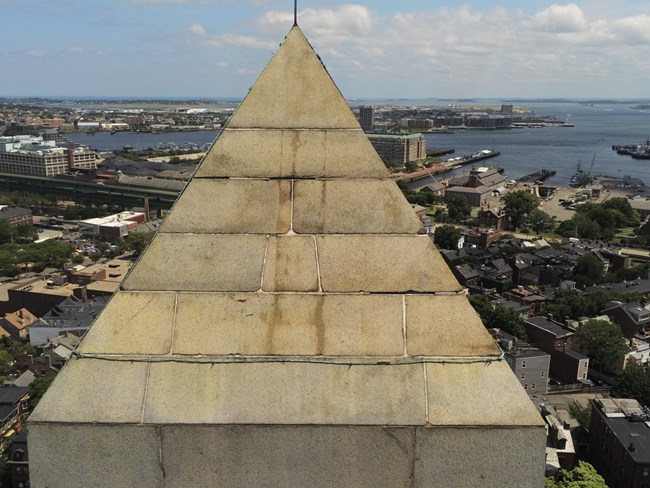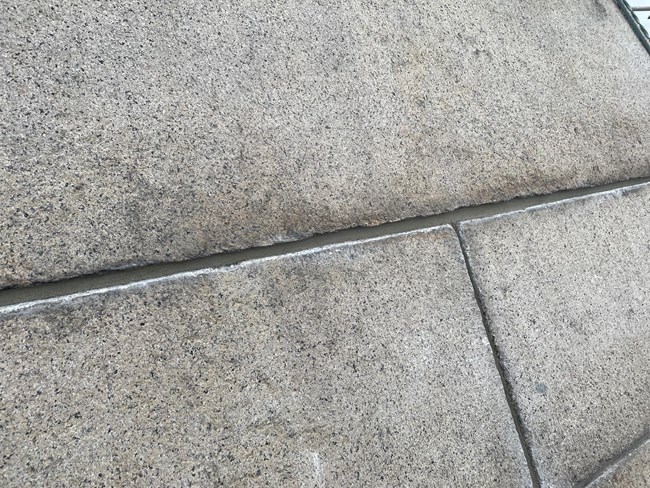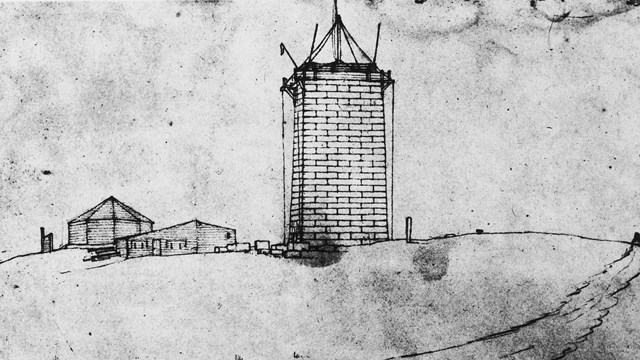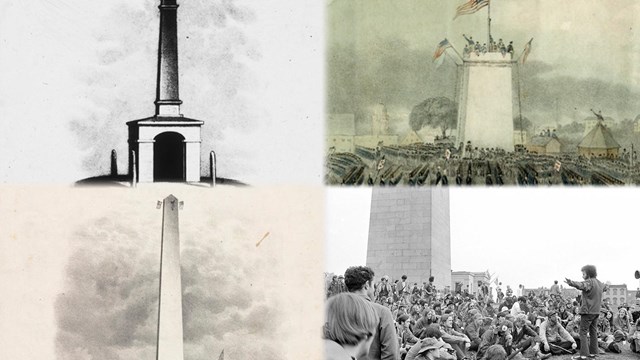Last updated: January 7, 2025
Article
Bunker Hill Monument Pyramidion Restoration, 2023

NPS Photo
Overview of Restoration Work
As the stewards of this iconic monument, the National Parks of Boston is taking action to preserve the Bunker Hill Monument to prevent additional and possibly irreparable damage.
In this project, workers will replace the mortar on the pyramidion roof and on the upper levels of the Monument. This work will prevent further leaks into the Monument; these leaks have led to the breakdown of mortar, deterioration of masonry, and slippery conditions in the stairway. This work on the Monument is necessary every 20 – 30 years.
In order to conduct this work, scaffolding will cover the entirety of the Monument. To put up and subsequently take down the scaffolding will take several weeks. Once the scaffolding is assembled, work can begin on the pyramidion.
This work is anticipated to conclude before the end of 2023.
Project Progress
Construction crews will raise fencing around the Monument to establish the construction zone. This area has been determined to best protect the public during the assembling of scaffolding and subsequent restoration work.
It will take several weeks to build the scaffolding around the Monument. Neighbors and visitors can expect the delivery of scaffolding materials to the Monument Grounds every Monday and Tuesday until the scaffolding has been completed.
Covered passageways have been completed to give visitors safe access to the Bunker Hill Lodge and Bunker Hill Monument during the restoration project. These passageways will be open to the public during the Monument's current hours of operation: Wednesday - Sunday from 10 a.m. - 4:30 p.m..
Scaffolding continues to be built around the Monument. The Bunker Hill Lodge and Bunker Hill Monument remain open to the public Wednesday - Sunday from 10 a.m. - 4:30 p.m.
On August 30, the National Parks of Boston hosted a Bunker Hill Monument Neighborhood Update at the Bunker Hill Museum. Historical Architect Lance Kasparian discussed the Monument's restoration and attendees asked park staff questions about building materials, comparisons and contrasts with the Dorchester Heights Monument, and upcoming events.
Masons are actively repointing the mortar joins between the granite blocks at the top of the Monument. After clearing away deteriorated and loose mortar, they will put in three courses of new mortar, allowing a full cure between each course.
Repointing work is now complete. Workers are now beginning to disassemble the staging. Public visitation of the Monument should not be disrupted; however, there may be intermittent short-term closures as needed.

NPS Photo
What is a Pyramidion?
A pyramidion is an equally sided pyramid that tops an obelisk. The Bunker Hill Monument's pyramidion serves as the roof of the Monument. About twenty granite blocks make up the exterior of the Monument's pyramidion, adding thirteen feet to the height of the Monument. Though the pyramidion's blocks make up a small fraction of the 3,000 blocks used to construct the Monument, they play a crucial role. These blocks help protect the Monument from the elements, like any roof does. The Monument's pyramidion also has a distinctive capstone, the very top of the Monument. This 2 ½ ton triangular granite block, the weight of a small car, was the last block hoisted into place when workers completed the Monument in 1842.
Current State of the Pyramidion
Just like the rest of the Monument, workers constructed the pyramidion out of granite blocks and mortar. Mortar is composed of cement and sand; it helps bind the granite blocks together and protects against weather. Over the years, the mortar near the outside surface of the granite blocks breaks down. Though the granite blocks are still bound together, gaps in the mortar leave the Monument vulnerable to the weather.
The slow deterioration of the mortar between the granite blocks in the pyramidion has led to water leaking into the Monument. This seepage has resulted in stains on the walls, floor, and dome of the observatory, the open space at the top of the Monument where visitors can enjoy a view the surrounding area. Water also washes out mortar between the granite blocks and causes damage to the masonry when it freezes and thaws.
The water leaking into the Monument through the pyramidion has also impacted the stairway. Slippery conditions on the stairs have resulted in Monument closures for visitor safety.
At 180 years old, the Bunker Hill Monument requires regular maintenance so it can remain preserved for many years to come.

NPS Photo
Work in Progress Updates
After several weeks constructing a full scaffold structure throughout August and September, masons went to work. After clearing out old lead flashing and loose and deteriorated mortar documented in the drone survey shown above, the masons began the process of replacing the mortar by mid-October. Several passes will take place over every join, with ample curing time between each course. This work is expected to take several weeks, depending on the weather.What Can Visitors Expect?
This preservation work will affect the Bunker Hill Monument Grounds from July 31 through the end of 2023. The timeline for this project has been influenced by the type of mortar work needed to restore the pyramidion, which requires warmer weather.
Visitors will be able to access the Monument grounds outside of the construction zone fencing. The National Parks of Boston plans to keep the Monument open as often as possible during this project, while also recognizing that construction and restoration work may cause the Monument to close without notice. When the Monument is open, a covered path will lead visitors from the Monument grounds to the Bunker Hill Lodge. Here, visitors will be able to enter the Monument.
Please note, the view from the Monument observatory windows will be obstructed due to scaffolding and scrim. Scrim is mesh netting, almost resembling a large cheese cloth. The Scrim will be wrapped around the scaffolding as a safety measure to protect construction crews and visitors. Visitors can view live footage from the top of the Bunker Hill Monument by visiting Views of the Revolution: 360 Monument Webcams.
Historical Significance of the Monument
Commemorating the Battle of Bunker Hill on June 17, 1775, Bunker Hill Monument has stood as a symbol for the nation’s hope and possibility since its opening in 1843. For generations, people have visited the Monument to remember and reflect on the motivations and enduring legacies of those who fought in the Battle of Bunker Hill.
Learn More...

Discover the great lengths Bostonians went in order to construct the iconic monument memorializing the Battle of Bunker Hill.

See what it is like at the top of Boston's Revolutionary War monuments right now!

How have people remembered the Battle of Bunker Hill and the monument that commemorates it at different moments in history?
